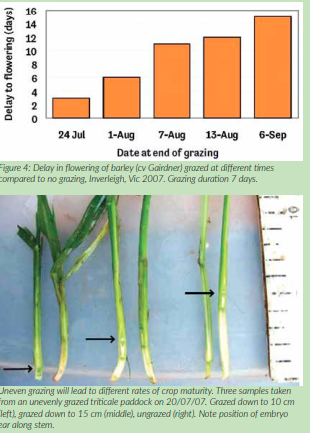Part 4 of the series on grazing cereals which is something being widely practiced across Australia in areas with widely
varying rainfall levels. The Australian Grain Research and Development Council have produced a report titled Grain and
Graze which sets out to evaluate the advantages and disadvantages of grazing a range of cash crops. We begin serializing this report over forth coming issues to explore what is currently an untapped resource.
Estimating how much dry matter is available
There are two methods to estimate the amount of dry matter available in a crop. The first method uses a simple relationship between crop height and dry matter (see side story 1). This approach is applicable in high rainfall regions where seeding rates of 80 to 100 kg/ha and narrow row spacing (15 to 20 cm) are used. In regions where row spacing is wider that 20 cm, seeding rates are lower and plant establishment is more variable, then the second method should be used, where crop cuts need to be taken (see side story 3).
When to start grazing
Deciding when to start grazing is the first consideration. Once the plants are anchored and have grown secondary roots the crops can be grazed. This usually occurs around the three leaf stage for cereals but may not if dry conditions are encountered after germination. To ensure adequate anchorage, apply the ‘pinch and twist test’ (side story 3). For canola it is recommended to commence grazing at the six to eight leaf stage when plants are well anchored but before the buds elongate more than 10 cm.

Ideally there should be 500 kg/ha to 800 kg/ha of dry matter per hectare for sheep (1000 kg/ha for cattle) to achieve high levels of animal performance. However in reality most crops may not have reached this amount of growth before grazing commences (refer to section 1). Postponing grazing until this benchmark is reached will limit the grazing opportunity for those who wish to minimise the impact on subsequent grain yield.
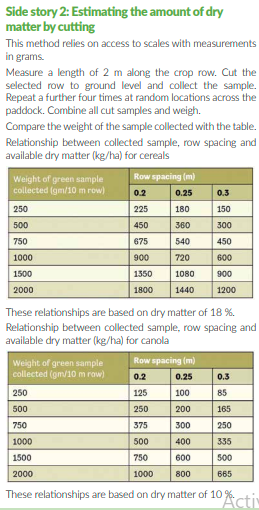
Grazing before these benchmarks is feasible although there will be a decrease in animal performance (table 1).
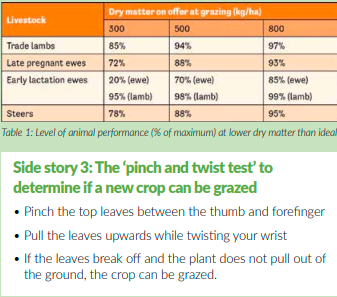
Withholding periods with herbicide
Some pre and most post emergent herbicides, seed treatments and many insecticides and fungicides have a withholding period from grazing after application. These can be as long as 15 weeks which can severely limit the grazing opportunity. Therefore, the timing of grazing and spraying operations need to be considered together. (A range of common herbicides used in crops for seed treatments, pre and post emergent weed control, fungicides and insecticides and their withholding periods is provided)
Grazing may improve the efficiency of weed control. For example, the use of grazing may enable certain broadleaf weeds to be controlled using a combination of a lower rate of herbicide with grazing (spraygraze technique).
A recent note posted on the Department of Agriculture and Food website in Western Australia reinforces the need to follow grazing withholding periods:
• The grazing withholding period (GWP) is the minimum time between chemical application and harvest for stockfeed or grazing to ensure the maximum reside limit (MRL) and/or export grazing interval (EGI) are not exceeded
• GWP are not about avoiding poisoning grazing animals, but ensuring animals are free of violative residues at slaughter
• It is a legal requirement to observe the GWP
• It is a requirement of ChemCert accreditation and Livestock Production Assurance (LPA) programs that chemical records are kept of when crops and pastures are treated, and of when grazing withholding periods expire.
How hard to graze
Deciding how much crop to leave behind can be contentious because it is a trade-off between maximising the feed on offer against the potential harm to grain ear formation and crop recovery. Earlier recommendations have been to graze the crop ‘to the white line’ (see side story 4) but subsequent work has shown this increases the risk of encountering a grain yield penalty, especially if conditions after grazing are not favourable. Under favourable recovery conditions, which is more likely in the higher rainfall areas, heavy grazing is less risky. The current approach used in lower rainfall areas is ‘clip’ grazing.
Clip grazing
This method involves a light grazing of the crop, with just the top few centimetres of the crop canopy removed. This is in contrast to the more traditional ‘crash’ grazing where a crop is heavily grazed, with the vast majority of the crop canopy eaten. Clip grazing can reduce the risk of incurring costly grain yield penalties in dry seasons and lower rainfall areas. This is achieved by leaving more leaf area for recovery after grazing, enabling the crop to produce more biomass by flowering. Biomass at flowering is a key determinant of eventual grain yield. Clip grazing also enables a crop to better compete with weeds post-grazing.

When to stop grazing
When to stop grazing is the third important decision. There are two parts to consider, firstly knowing when the plants commence stem elongation (GS 30) and secondly allowing sufficient time for plant recovery to ensure grain fill.
Growth stage 30
It is currently recommended that grazing with sheep is completed by GS 30 if the aim is to minimise the risk of grain yield loss (see side story 5). For cattle, grazing needs to be completed before GS 32 is reached because they do not graze as low.
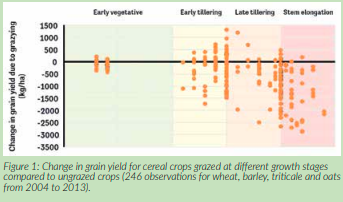
Grazing can continue after these benchmark growth stages, but the chances and magnitude of the loss in grain yield increases dramatically (figure 1). For regions where crops are sown purely to provide dry matter (DM) for grazing, there is no need to worry about damaging the embryonic ear of the plant.
Figure 1 clearly shows the increased chances of grain yield loss if grazing occurs after the start of stem elongation (reproductive growth). Grazing after the plant begins stem elongation risks damaging the ear.
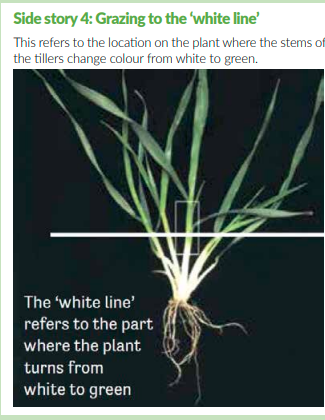
Unfortunately, predicting the changes in crop development cannot be determined by a date on the calendar (although crops with a winter habit are more predictable). Visual observation of the emerging embryo ear is the only way to accurately assign this growth stage of a crop. There is a common referencing system that helps describe the development of a cereal plant from germination through to ripening. It consists of ten (10) development phases from zero to nine (0 to 9). Within each development phase there are up to ten (10) individual growth stages. This gives a two number code and is prefaced with the letters GS for growth stage. When making decisions about grazing winter crops, the change from GS 2 to GS 3 is critical. GS 2 refers to the development phase when the plant is tillering or producing stems at each crown. GS 3 refers to the development phase when the plant stops tillering and the embryo ear which has formed in the base of each tiller begins to move up the tiller. This phase is also characterised by each tiller beginning to thicken into stems, and nodes forming low down on each tiller. The key growth stage observations to accurately determine a growth stage are described (table 2 and side story 5).
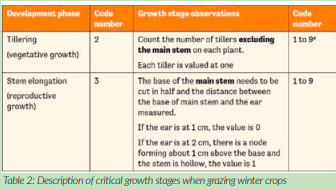
A plant in vegetative growth with a main stem and four tillers would be described as GS 24. The same plant would be described as GS 31 when the ear is about 2 cm above the base of the plant, a hollow is forming beneath the ear and a ring or node is forming about 1 cm above the base of the plant. The method of dissecting a plant to test for growth stage is described (see side story 5).
Crop recovery after grazing
Stresses on the crop after grazing can affect plant recovery and grain yield. Moisture deficiencies and high temperatures can restrict regrowth of leaves and the aborting of tillers in the period up to flowering. The importance of these influences is being examined in the current Grain and Graze 3 program.
While there is no way of predicting what conditions may prevail in the period between grazing and flowering, limited soil water at grazing will increase the risk of a yield loss, even in the high rainfall zone. Observations from a trial in South West Victoria during the 2006 drought shows a dramatic reduction in grain yield of two long season wheat varieties compared to the ungrazed crop, even though GS 30 had not been reached. Soil moisture probes indicated the crop had reached wilting point (no soil moisture available for plant growth) during late August, so despite grazing before GS 30, crop recovery was poor which led to lower grain yield (figure 2).
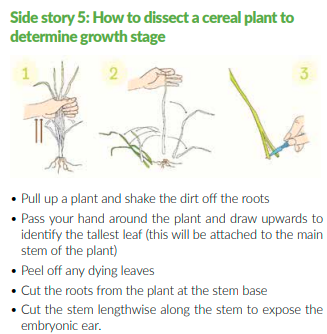
Modelling by the CSIRO6 for the high rainfall zones in Western and Southern Australia provided an indicative end grazing date for winter type wheats sown in mid-March, Mid-April and Mid-May which would enable enough time for crop recovery before flowering (figure 3). The end grazing date was determined when GS 30 was reached or when only 200 kg/ha of crop dry matter remained after grazing (grazed at 25 DSE/ha, commencing when 1000 kg/ha of dry matter was available). However field experience would suggest earlier end of grazing with later sowing dates may be wise.
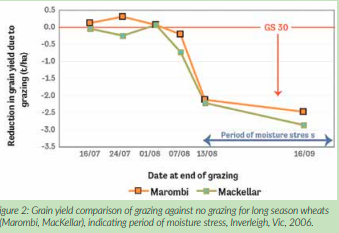
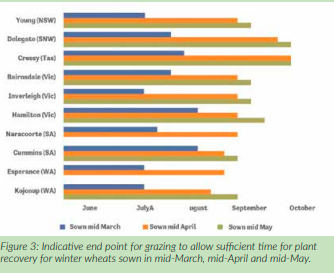
Delay in crop maturity
Grazing delays the maturity of a crop. Trial data would indicate the delay to maturity is between three and 14 days, although this will vary depending on when grazing commences and the duration of grazing. In Western Australia, where crops are grazed early, the common rule is 1 day of delay in flowering for every two days of grazing7. So a crop grazed for 20 days would have flowering delayed by approximately 10 days. In areas where crops are grazed later, delayed grazing delays maturity more so than early grazing (figure 4).
Delayed maturity has both positive and negative implications. If the crop cannot be grazed evenly there will be variability in crop ripening, which may create difficulties at harvest, especially with barley which is prone to drop grain heads when mature. On the positive side, grazing may be used strategically to delay flowering that may avoid damage caused by late frosts. Yet it may push maturity into a period of late moisture and/or heat stress.
